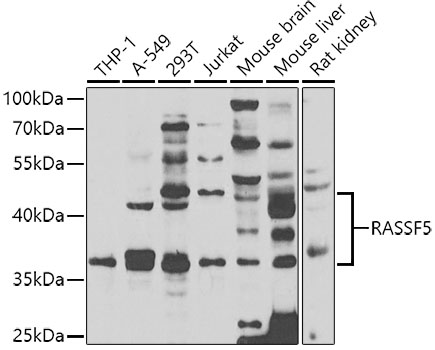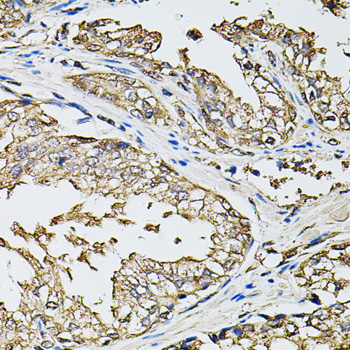-
Product Name
RASSF5 Polyclonal Antibody
- Documents
-
Description
Polyclonal antibody to RASSF5
-
Tested applications
WB, IHC
-
Species reactivity
Human, Mouse, Rat
-
Alternative names
RASSF5 antibody; Maxp1 antibody; NORE1 antibody; NORE1A antibody; NORE1B antibody; RAPL antibody; RASSF3 antibody; Ras association domain family member 5 antibody
-
Isotype
Rabbit IgG
-
Preparation
Antigen: Recombinant fusion protein containing a sequence corresponding to amino acids 1-265 of human RASSF5 (NP_872606.1).
-
Clonality
Polyclonal
-
Formulation
PBS with 0.02% sodium azide, 50% glycerol, pH7.3.
-
Storage instructions
Store at -20℃. Avoid freeze / thaw cycles.
-
Applications
WB 1:500 - 1:2000
IHC 1:50 - 1:200 -
Validations

Western blot - RASSF5 Polyclonal Antibody
Western blot analysis of extracts of various cell lines, using RASSF5 antibody at 1:1000 dilution.Secondary antibody: HRP Goat Anti-Rabbit IgG (H+L) at 1:10000 dilution.Lysates/proteins: 25ug per lane.Blocking buffer: 3% nonfat dry milk in TBST.Detection: ECL Basic Kit .Exposure time: 90s.

Immunohistochemistry - RASSF5 Polyclonal Antibody
Immunohistochemistry of paraffin-embedded human prostate using RASSF5 antibody at dilution of 1:100 (40x lens).
-
Background
Potential tumor suppressor. Seems to be involved in lymphocyte adhesion by linking RAP1A activation upon T-cell receptor or chemokine stimulation to integrin activation. Isoform 2 stimulates lymphocyte polarization and the patch-like distribution of ITGAL/LFA-1, resulting in an enhanced adhesion to ICAM1. Together with RAP1A may participate in regulation of microtubule growth. The association of isoform 2 with activated RAP1A is required for directional movement of endothelial cells during wound healing. May be involved in regulation of Ras apoptotic function. The RASSF5-STK4/MST1 complex may mediate HRAS and KRAS induced apoptosis.
Related Products / Services
Please note: All products are "FOR RESEARCH USE ONLY AND ARE NOT INTENDED FOR DIAGNOSTIC OR THERAPEUTIC USE"
